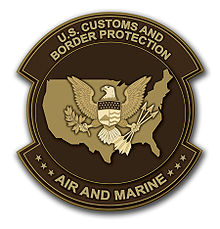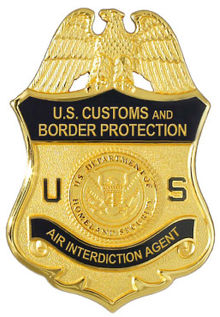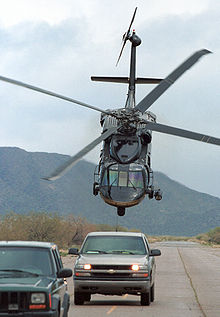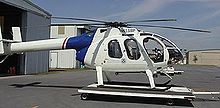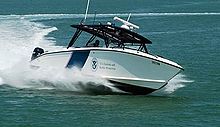- Office of CBP Air and Marine
-
The mission of the United States Customs and Border Protection Office of Air and Marine (CBP OAM), the world’s largest aviation and maritime law enforcement organization, is to protect the American people and Nation’s critical infrastructure through the coordinated use of integrated air and marine forces to detect, interdict and prevent acts of terrorism and the unlawful movement of people, illegal drugs and other contraband toward or across the borders of the United States.
This specialized law enforcement capability allows CBP OAM to make significant contributions to the homeland security efforts of DHS, as well as to those of Federal, State, local, and tribal agencies. To accomplish this mission, CBP OAM utilizes over 900 Federal Agents, operating from 75 air and marine locations, with more than 285 aircraft of 22 different types, and more than 200 maritime vessels. As of September 2007[update], it is one of four major offices operating under U.S. Customs and Border Protection (CBP).[1]
Contents
Consolidation
On October 1, 2005, CBP integrated its aviation assets, programs and personnel into one organization to more effectively accomplish its aviation missions. With over 500 pilots and 250 aircraft, CBP OAM is the largest law enforcement air force in the world.
On January 17, 2006, CBP consolidated all marine assets, program and personnel and placed them under the newly titled CBP Office of Air and Marine, with responsibility for marine training, safety and standards, equipment, vessel procurement and maintenance.
In 2009 CBP’s Office of Air and Marine is the largest aviation and maritime law enforcement organization in the world, utilizing over 700 pilots, operating more than 290 aircraft of 22 different types including the use of unmanned aircraft systems (UAS).[2]
The marine program has approximately 200 vessels, including 39-foot Midnight Interceptors and two models of Safe Boats.
Operations
CBP uses its aviation assets for anti-terrorism, to staunch drug smuggling, and for additional missions in support of the Department of Homeland Security, Immigration and Customs Enforcement, Joint Interagency Task Force-South, and other federal, state and local law enforcement partners.
CBP uses its marine force to apprehend unauthorized vessels carrying contraband or illegal aliens. CBP’s marine program employs vessels including blue water, interceptor, and utility vessels. These are used for strategic operations in high-risk entry areas. CBP marine crews also work with other U.S. agencies, and military forces of other nations to support their law enforcement efforts, especially in their counter-narcotic programs.
The CPB's Unmanned Aircraft Systems Office utilizes civilianized versions of several military UAVs to patrol the U.S. border. [3]
Aviation Resources
The P-3 Airborne Early Warning (AEW) Detection and Monitoring (D&M) aircraft are the only law enforcement AEW aircraft in the world. They were developed to provide wide area search, increased command control, and communications capabilities.
CBP OAM’s P-3s are high-endurance, all-weather, tactical turbo-prop aircraft, which are utilized primarily for long-range patrols along the entire U.S. border, and in source and transit zone countries, throughout Central and South America. The aircraft carries a crew of eight (pilot, copilot, flight engineer, and radar/sensor operators), are routinely sent on temporary duty to support the United States and foreign government initiatives to stem smuggling into the United States. With the escalation of terrorist threats and the commitment of DoD AEW assets in other regions of the world, CBP OAM P-3s have also assumed a significant role in Homeland Security efforts.
Lockheed Orion P-3 Long Range Tracker (LRT)
The P-3 LRT aircraft are high-endurance, all-weather, tactical turbo-prop aircraft used by CBP OAM to intercept and track airborne smuggling threats. With the escalation of terrorist threats and the commitment of DoD AEW assets in other regions of the world, CBP OAM P-3s have assumed a significant role in Homeland Security efforts.
Key to the success of the P-3’s are their endurance, small deployment footprint, and extensive sensor array. The aircraft can operate from most 8,000-foot runways and carries a crew of eight (pilot, copilot, flight engineer, and radar/sensor operators). The aircraft are supported by a ground maintenance team of only three people.
CBP OAM P-3 LRT aircraft often fly in tandem with the P-3 AEW. Used in this manner, the P-3 AEW detects and tracks multiple targets and the accompanying P-3 LRT long-range tracker, intercepts, identifies and tracks those suspect targets.
The Bombardier Dash 8 Q200 is a multirole patrol aircraft (MPA) equipped with multimode radar and electro-optical/infrared sensors that can detect and track maritime and surface targets. It can also be converted to a cargo configuration or into a 37-passenger aircraft, making it an ideal aircraft to respond to acts of terrorism, natural disasters and other emergencies.
The first CBP OAM Dash 8 Q200 MPA was placed in service in August 2005 and was used extensively during the days following Hurricane Katrina to carry law enforcement officers, flight crews and other personnel, supplies and equipment to New Orleans. A second Dash 8 was delivered in mid 2006 and a third aircraft was delivered in February 2008. The fourth aircraft was delivered in December 2008.
File:C550citationC-550 CitationCessna Citation II Interceptor aircraft are all-weather tactical jets used by CBP OAM to intercept and track airborne drug smugglers and to enforce airspace security over critical venues. The Citation has also been used effectively in Panama, Honduras, Colombia, Peru, Venezuela, Mexico and Aruba.
CBP OAM began utilizing the Cessna Citation in the late 1970s as a high-speed interceptor and tracker.
CBP OAM’s Citation Interceptors, which fly with a crew of three (pilot, copilot, and sensor operator), have the ability to operate from remote landing strips. The Citation II were the first commercial aircraft fitted with fire-control radar from the USAF F-16 Falcon, to be used in a law enforcement capacity.
The Pilatus PC-12 is the single-engine turbo-prop aircraft that will replace the aging C-12 Huron aircraft currently in CBP OAM’s fleet. The PC-12 combines the slow-speed capability of a Cessna 210 with the payload and high-speed capabilities of a C-12 Huron. These characteristics enable the Multirole Enforcement Aircraft to deploy rapidly and operate safely in remote areas.
These aircraft have enhanced the effectiveness and efficiency of CBP OAM by providing:
1. Increased mission versatility, including air interdiction, aerial surveillance and logistical support 2. Removable sensor consoles and retractable state of-the-art EO/IR sensors 3. Reduced operating costs
Key to the success of the PC-12s, which fly with a crew of two (pilot and sensor operator), are their endurance, small deployment footprint, and extensive sensor array. The aircraft have short-field capabilities of mission take-off in 2,300 ft. and landing distance of 1,800 ft.
The Cheyenne III Interceptor are high-endurance, all-weather, tactical turbo-prop aircraft, designed for CBP OAM specifically for long-range missions with fire-control radar from the USAF F-16 Falcon and FLIR. These aircraft, which fly with a crew of three (pilot, copilot, and sensor operator), can operate from remote landing strips and are utilized to intercept and track airborne smugglers.
The King Air, C-12C, and C-12M maritime surveillance aircraft are a medium range, twin turbo-prop aircraft used by CBP OAM. These aircraft support investigation and enforcement efforts by conducting surveillance, tracking, and intelligence missions with equipment specifically designed for missions, to include over water operations.
Their secondary mission is the logistical relocation of personnel, equipment, or evidence that is time critical to investigation and enforcement actions. As an interdiction tracker, this aircraft can play a role in drug interdiction missions when accompanied by the C-550 Interceptor or a P-3 flying as a radar platform or an Interceptor.
In September 2009 Sierra Nevada Corporation was awarded a competitive contract to provide Air and Marine Multirole Enforcement Aircraft (MEA) based on the Beechcraft King Air 350ER.[4]
The C-172/182 surveillance aircraft are short to medium-range, piston-powered aircraft used by the CBP OAM to support investigative and enforcement efforts by conducting surveillance, tracking, photographic and intelligence gathering missions.
CBP OAM’s C-172/182 surveillance aircraft, which fly with a crew of two (pilot and observer), are particularly effective platforms for law enforcement operations. They provide better range and endurance than helicopters and blend more effectively with local traffic to mask the presence of continuous air surveillance.
Cessna C-206/210 Turbo Centurion
The C-206/210 surveillance aircraft are short- to medium range, piston-powered aircraft used by CBP OAM to support investigative and enforcement efforts by conducting surveillance, tracking, photographic and intelligence gathering missions.
Their secondary mission is the logistical relocation of personnel, equipment or evidence that are time critical to investigative and enforcement actions.
CBP OAM’s C-206/210 surveillance aircraft, which fly with a crew of two (pilot and observer), are very effective platforms for law enforcement operations outside of large metropolitan areas. They provide better range and endurance than helicopters and blend more effectively with local traffic to mask the presence of continuous air surveillance.
The Piper PA-18 aircraft are short- to medium-range, piston-powered aircraft used by CBP OAM to support enforcement efforts by conducting tracking and general support for ground units.
PA-18 Light Enforcement aircraft have a standard crew of one Pilot and are effective platforms for law enforcement operations due to their ability to fly slow and loiter in an area for prolonged periods. They provide better range and endurance and blend more effectively with local traffic to mask the presence of continuous air surveillance.
Sikorsky UH-60 Black Hawk
UH-60A Black Hawk helicopters are long-distance, all weather, tactical apprehension aircraft used by the CBP OAM to protect the American public from threats of terrorism and drug smuggling and to enforce airspace security over critical venues.
CBP OAM’s UH-60As, which usually fly with a crew of three (pilot, copilot and crew members), are large, powerful helicopters, which can carry all the equipment and personnel necessary for law enforcement operations without sacrificing range and speed. In addition, they are well suited to the all weather hazardous environments in which CBP OAM routinely operates.
AW-139 helicopters are long-distance, all weather, tactical apprehension aircraft used by the Office of Customs and Border Protection Air and Marine to protect the American public from threats of terrorism and drug smuggling and to enforce airspace security over critical venues.
CBP OAM’s AW-139s, which usually fly with a crew of three (pilot, copilot and crewmember), are large, powerful helicopters, which can carry all the equipment and personnel necessary for law enforcement operations without sacrificing range and speed. In addition, they are well suited to the all weather hazardous environments in which CBP OAM routinely operates.
Bell UH-1
The UH-1 Helicopters are short- to medium-range, turbine-powered helicopters used by CBP OAM to perform tactical and utility missions along the border.
The UH-1 heavy lift capability allows the aircraft to be support agents in high altitude and hot environments
CBP OAM’s UH-1 Helicopter flies with a crew of 2 (pilot and copilot) and has a secondary mission to provide lift recovery, through external capabilities of drug seizures and equipment.
Aerospatiale AS-350 A-Star
The AS-350 Surveillance Helicopters are medium-range, turbine-powered helicopters used by CBP OAM to perform aerial reconnaissance of stationary or moving targets.
Light Enforcement Helicopters (LEH) are the optimal aerial surveillance platform in metropolitan areas because their vertical lift capability and maneuverability enable operations from off-airport sites and in close proximity to congested airports. EO/IR sensors and video downlink provide intelligence and communications support that enhance officer safety during high-risk operations and increase covertness during surveillance operations. Video recorders document suspect activities for evidentiary use. The AS-350s, which fly with a crew of two (pilot and observer), are one of the few helicopters that maintain their performance from sea level up to 9,000 feet.
MD-600 Light Enforcement Helicopters (LEH) are medium-range, turbine-powered helicopters used by CBP OAM to perform aerial reconnaissance; including tracking along the borders and coasts.
The MD-600 LEH is an effective aerial surveillance platform. It is used in the desert, as well as in metropolitan and coastal areas. Its quiet noise signature and maneuverability enable operations from off-airport sites, delicate environmental sites and in metropolitan areas.
CBP OAM’s MD-600 LEH, which fly with a crew of 1, are quiet and useful aerial surveillance platforms supporting law enforcement and border protection throughout the United States.
MD-500 Light Enforcement Helicopters (LEH) are short- to medium-range, turbine-powered helicopters used by CBP OAM primarily as a light observation helicopter for tracking and general support for ground units.
The MD-500 is a highly effective aerial surveillance platform in border areas. Its maneuverability enables operations from off-airport sites and in metropolitan areas.
CBP OAM’s MD-500 Light Enforcement Helicopter flies with a crew of 1(Pilot).
OH-6 Helicopters are short- to medium-range, turbine-powered helicopters used by CBP OAM primarily as a light observation helicopter for tracking and general ground unit support.
CBP OAM’s OH-6 Helicopter, which flies with a crew of 1 (pilot), is a highly effective aerial surveillance platform in the border desert areas. Its lifting capability and maneuverability enable operations from off-airport sites and in metropolitan areas of the United States.
American Eurocopter EC120
EC-120 Helicopters are short-to-medium-range, turbine-powered helicopters which will be used by CBP OAM primarily as a light observation helicopter for tracking and general ground unit support.
CBP OAM’s EC-120 helicopter, which flies with a crew of 1 (Pilot), will provide a highly effective aerial surveillance platform in the border desert areas.
Unmanned Aircraft System MQ-9 Predator B
The MQ-9 Predator B Unmanned Aircraft System (UAS) augments CBP OAM assets supporting ground interdiction agents on the Southwest Border. In January 2009, UAS operations began on the Northern Border. CBP OAM is engaged in the Department of Homeland Security’s (DHS) mission to prevent terrorist attacks within the United States.
CBP selected the Predator B for its large payload and ability to remain in the air longer than other UASs. CBP’s Air and Marine Operations Center (AMOC) in Riverside, CA will provide command and control of the UAS through KU-band satellite communications.
The Predator B is a force multiplier for CBP and its border security mission. In addition, it has the potential to allow CBP to coordinate operations within other DHS organizations, including the U.S. Coast Guard and the Federal Emergency Management Agency. CBP OAM works closely with the Department of Defense to gain efficiencies in acquisition, testing, training and deployment of the Predator B.
Marine Resources
CBPs Office of Air and Marine utilizes over 360 marine agents through the coordinated use of air and marine forces to detect, interdict, and prevent acts of terrorism and the unlawful movement of people, illegal drugs and other contraband toward or across the borders of the United States. The OAM operates with more than 220 vessels including the 39-foot Midnight Interceptor and two models of Safe Boats.
Interceptor Class 39-FT. Midnight Express
CBP OAM utilizes two types of Interceptor vessels, the 39-ft Midnight Express and the 33-ft SAFE Boat.
The 39-ft Midnight Express is an integral part of the CBP OAM’s efforts to stop maritime smuggling into the United States.
Working in conjunction with CBP OAM aviation assets, the Midnight Express operates in offshore coastal waters to combat maritime smuggling and protect U.S. ports from acts of terrorism.
The Midnight Express crews work in conjunction DHS, DOD and other federal, state and local law enforcement agencies to accomplish the Homeland Security mission.
Interceptor Class 33-FT. Safe Boat
CBP OAM utilizes a 33-foot Secure-Around-Flotation-Equipped (SAFE) Boat, with fabricated marine-grade aluminum hulls and polyethylene closed cell foam collars. This characteristic provides the stability and the buoyancy of a ridged hull inflatable, with an unmatched durability and safety factor. These features make it ideal for performing law enforcement missions in rough seas and in areas congested with waterborne debris. The protective cabin area of the SAFE Boat has heat and air to protect the crews from the elements.
CBP OAM uses the SAFE Boats for the pursuing and boarding (inland and offshore) of vessels transiting in rough waters and locations with extreme weather conditions. The SAFE Boat crews work in conjunction DHS, DOD and other and other federal, state and local law enforcement agencies to combat maritime drug smuggling and protect U.S. ports from acts of terrorism.
Coastal Enforcement Class 30-FT. Intrepid
The Coastal Enforcement Class Vessels serve as a multi-purpose law enforcement vessel. The 30-ft Intrepid best fulfills this multi-mission requirement. The hull design makes it ideal for enforcement operations in shallow, inland and near coastal waters. The Intrepid can also be utilized for both covert and overt missions. The typical open fisherman type configuration allows the law enforcement crew to covertly survey illegal activity.
The vessel’s shallow draft allows for pursuit of smugglers who offload contraband in remote and shallow regions. The starboard-side dive door allows for easy pick-up of floating contraband.
The Intrepid meets the demands for a small, fast, highly maneuverable vessel that can be used to interdict, patrol, conduct surveillance and port security activities that are the missions of CBP OAM.
Its versatility allows CBP OAM to provide DHS, DOD, and other law enforcement agencies, viable and effective maritime law enforcement support.
See also
References
- ^ http://nemo.cbp.gov/obp/am_sfx.wmv
- ^ http://www.cbp.gov/xp/cgov/border_security/air_marine/air/
- ^ http://www.cbp.gov/xp/cgov/border_security/air_marine/uas_program/
- ^ http://www.marketwire.com/press-release/Sierra-Nevada-Corporation-1053408.html
- ^ http://www.cbp.gov/xp/cgov/border_security/air_marine/air/aviation_asset/
- ^ http://www.cbp.gov/xp/cgov/border_security/air_marine/marine/
CBP Air and Marine Photo Gallery
External links
Categories:
Wikimedia Foundation. 2010.

